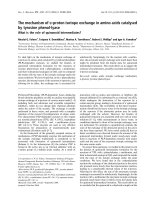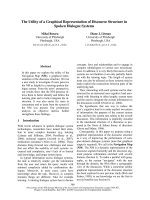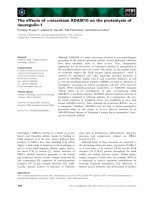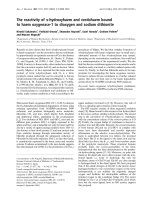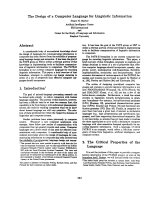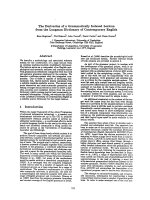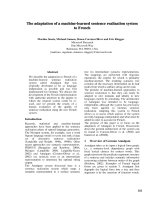Báo cáo toán học: "The Rank of a Cograph" pptx
Bạn đang xem bản rút gọn của tài liệu. Xem và tải ngay bản đầy đủ của tài liệu tại đây (79.42 KB, 7 trang )
The Rank of a Cograph
Gordon F. Royle
Department of Computer Science & Software Engineering
University of Western Australia, Australia
Submitted: Mar 1, 2002; Accepted: Aug 21, 2003; Published: Sep 17, 2003
MR Subject Classifications: 05C50
Abstract
The rank of the adjacency matrix of a graph is bounded above by the number
of distinct non-zero rows of that matrix. In general, the rank is lower than this
number because there may be some non-trivial linear combination of the rows equal
to zero. We show the somewhat surprising result that this never occurs for the class
of cographs. Therefore, the rank of a cograph is equal to the number of distinct
non-zero rows of its adjacency matrix.
1 Introduction and Motivation
The rank of a graph X is the rank of its adjacency matrix A(X). As the rank is such
a fundamental algebraic concept, the relationship between the structure of a graph and
its rank is a natural topic of study for algebraic graph theorists. Perhaps the most well-
known of such investigations is the study of the relationship between the rank and the
chromatic number of a graph (see Alon & Seymour [1]). Despite this and other efforts,
there is surprisingly little that can be said about the rank of the adjacency matrix of a
graph. In general, the known results are limited to calculations of the rank in special
cases, or how the rank varies under certain operations (for example, see Bevis et.al [2]).
In fact, considerably more is known about the rank of other matrices associated with a
graph, or about the ranks of certain graphs over finite fields (for examples, see Godsil &
Royle [7]).
In calculating the rank of a graph, the maximum value that it can take is the number
of distinct non-zero rows of the adjacency matrix. In general, these will not be lin-
early independent, and the rank will be somewhat lower. While experimenting on the
rank-chromatic number question by computer, Torsten Sillke [8] observed that for all the
cographs he checked, the rank turned out to be precisely equal to the number of dis-
tinct non-zero rows of the adjacency matrix, and he conjectured that this was true for all
cographs.
the electronic journal of combinatorics 10 (2003), #N11 1
The purpose of the current paper is to provide a proof for this conjecture, thereby
demonstrating that cographs always have “maximal rank” in this sense. The result is cu-
rious in several ways — firstly, there are so few existing results connecting graph structure
and rank, and secondly because there is no clear reason why cographs should crop up in
this fashion. There does not appear to be any other natural class of graphs for which an
analogous result is true.
For general background regarding graphs, we recommend Diestel [6], and for the alge-
braic graph theory concepts and notation Godsil & Royle [7].
2 Cographs
Complement-reducible graphs,orcographs, are the graphs belonging to the following re-
cursively defined family:
1. K
1
is a cograph,
2. If X is a cograph, then so is its complement
X,and
3. If X and Y are cographs, then so is their union X ∪ Y .
This class of graphs has been extensively studied for many years, both from the com-
putational viewpoint and the graph-theoretical viewpoint. Studies in the former area have
led to fast algorithms for the recognition of cographs, and for the restricted versions of
many standard graph-theoretic problems such as colouring, matching, isomorphism etc.
Studies in the latter area have led to many different characterizations of cographs, some
of which have become so well known that they are now equally often used as the definiton
of cographs. The most well-known of these characterizations is probably the following:
Theorem 2.1 A graph is a cograph if and only if it does not have the path P
4
as an
induced subgraph.
The classic reference for cographs is the paper by Corneil et. al [4], and we refer the
reader to the book Graph Classes by Brandst¨adt, Le and Spinrad [3] for further details
and more recent references.
We will use a slightly different characterization of cographs as the foundation for later
inductive proofs. This uses the concept of the join of two graphs X and Y ,whichisthe
graph X Y obtained by joining every vertex of X to Y .Itiseasytoseethat
X Y =
X ∪ Y.
Lemma 2.1 Let C be the class of graphs defined as follows:
1. K
1
is in C,
the electronic journal of combinatorics 10 (2003), #N11 2
2. If X and Y are in C, then so is their union X ∪ Y , and
3. If X and Y are in C, then so is their join X Y .
Then C is the class of cographs.
3 Spectrum of a cograph
The characteristic polynomial ϕ(X) of the graph X is the characteristic polynomial of its
adjacency matrix A(X). The spectrum of X is the collection of eigenvalues of A(X), or
equivalently, the collection of zeros of ϕ(X). The rank of X is the number of non-zero
values occurring in the spectrum.
In order to study the spectra of cographs, we need to know how the characteristic
polynomial behaves under the operations of union and join. The following result is from
Cvetkovic, Doob and Sachs [5].
Theorem 3.1 Let X and Y be graphs on x and y vertices respectively. The characteristic
polynomial of the graph X ∪ Y is given by
ϕ(X ∪ Y )=ϕ(X)ϕ(Y ),
and the characteristic polynomial of X Y is given by
ϕ(X Y,λ)=(−1)
y
ϕ(X, λ) ϕ(Y,−λ − 1)
+(−1)
x
ϕ(Y, λ) ϕ(X,−λ − 1)
−(−1)
x+y
ϕ(X,−λ − 1) ϕ(Y,−λ − 1).
We will be using this specifically for the eigenvalues 0 and −1 and so reproduce the
relevant expressions in those cases:
ϕ(X Y,0)=(−1)
y
ϕ(X, 0) ϕ(Y,−1)
+(−1)
x
ϕ(Y, 0) ϕ(X,−1)
−(−1)
x+y
ϕ(X,−1) ϕ(Y,−1).
ϕ(X Y, −1)=(−1)
y
ϕ(X, −1) ϕ(Y,0)
+(−1)
x
ϕ(Y, −1) ϕ(X, 0)
−(−1)
x+y
ϕ(X,0) ϕ(Y,0).
the electronic journal of combinatorics 10 (2003), #N11 3
Lemma 3.1 The graph K
1
X has −1 as an eigenvalue if and only if X has 0 as an
eigenvalue.
Proof. Recall that ϕ(K
1
,λ)=λ, and so substituting X = K
1
, x =1,Y = X and
y = x into the above expression we get
ϕ(K
1
X, −1) = (−1)
x
(−1)ϕ(X,0)
which is 0 if and only if ϕ(
X,0)=0.
Our next result is the key observation, relating the eigenvalues 0 and −1 for a cograph
and its complement. It implies that the value
p(X):=(−1)
|V (X)|
ϕ(X, 0)ϕ(X,−1)
is always zero or negative when X is a cograph.
Theorem 3.2 If Z is a cograph then
(−1)
|V (Z)|
ϕ(Z, 0)ϕ(Z,−1) ≤ 0.
Proof. We prove this by induction on the number of vertices of Z. It is true for
Z = K
1
;ifZ has more than one vertex, then it is either the union or join of two smaller
cographs X and Y .
When Z = X ∪ Y ,wehave
p(Z)=(−1)
x+y
ϕ(X ∪ Y,0) ϕ(X Y,−1)
=(−1)
x+y
ϕ(X, 0) ϕ(Y,0) ×
(−1)
y
ϕ(X,−1) ϕ(Y,0) + (−1)
x
ϕ(Y,−1) ϕ(X, 0)
−(−1)
x+y
ϕ(X, 0) ϕ(Y,0)
=(−1)
x
ϕ(X, 0) ϕ(X,−1) ϕ(Y,0)
2
+(−1)
y
ϕ(Y, 0) ϕ(Y,−1) ϕ(X, 0)
2
−ϕ(X, 0)
2
ϕ(Y, 0)
2
.
By the inductive hypothesis, the first two terms of this sum are non-positive, and
clearly the final term is non-positive, and so p(Z) ≤ 0.
When Z = X Y ,wehave
p(Z)=(−1)
x+y
ϕ(X Y, 0) ϕ(X ∪ Y,−1)
=(−1)
x+y
ϕ(X,−1) ϕ(Y,−1) ×
(−1)
y
ϕ(X, 0) ϕ(Y,−1) + (−1)
x
ϕ(Y, 0) ϕ(X,−1)
−(−1)
x+y
ϕ(X,−1) ϕ(Y,−1)
=(−1)
x
ϕ(X, 0) ϕ(X,−1) ϕ(Y,−1)
2
+(−1)
y
ϕ(Y, 0) ϕ(Y,−1) ϕ(X,−1)
2
−ϕ(X,−1)
2
ϕ(Y,−1)
2
.
the electronic journal of combinatorics 10 (2003), #N11 4
Once again, the inductive hypothesis yields that the first two terms are non-positive,
and the final term is the negation of a square.
This proof can be examined more carefully to give additional information about equal-
ity; notably we can see that a cograph can only have −1 as an eigenvalue if its complement
has 0 as an eigenvalue.
Corollary 3.1 If Z is a cograph then
(−1)
|V (Z)|
ϕ(Z, 0)ϕ(Z, −1) = 0
if and only if ϕ(Z, 0)=0.
Proof. This is true for the graph K
1
, and so it suffices to prove it for the union and
join of two smaller cographs. If p(X Y ) = 0, then all three terms in the expression
for p(X Y ) are equal to 0, and exchanging X and Y if necessary, we may assume that
ϕ(
X,−1) = 0. By the inductive hypothesis, this shows that ϕ(X, 0) = 0 and substituting
these values into the expression for ϕ(X Y ) yields that ϕ(X Y ) = 0 as desired.
If p(X ∪ Y ) = 0, then similarly we may assume that ϕ(X, 0) = 0 and it follows imme-
diately that ϕ(X ∪ Y )=0.
Finally we finish with a simple restatement of the expression given earlier for ϕ(X
Y,0)
ϕ(X, 0)ϕ(Y,0) − ϕ(X Y,0) =
ϕ(X, 0) − (−1)
x
ϕ(X,−1)
ϕ(Y, 0) − (−1)
y
ϕ(Y,−1)
.
4 Rank of a cograph
This section proves the main result of the paper first for the case where every row of A(Z)
is distinct and non-zero, and then extending this to the general case.
Theorem 4.1 Let Z be a cograph where every row of A(Z) is distinct and non-zero.
Then Z has full rank (that is, rank equal to |V (Z)|).
Proof. We will prove this by induction on |V (Z)|. Clearly it is true if | V (Z)| =2
because the only cograph of full rank on two vertices is K
2
. Therefore we consider the
cases where Z = X ∪ Y ,andZ = X Y . In each case we show that X has full rank by
showing that it does not have zero as an eigenvalue.
In the case where X = X ∪ Y , it is immediate that the rows of A(X)andA(Y )are
distinct and non-zero, so by the inductive hypothesis X and Y have full rank, and hence
do not have zero as an eigenvalue. The spectrum of X ∪ Y is the union of the spectra of
X and Y ,andsoX ∪ Y does not have zero as an eigenvalue.
the electronic journal of combinatorics 10 (2003), #N11 5
Therefore, consider the case where Z = X Y , and recall that
ϕ(X, 0)ϕ(Y,0) − ϕ(X Y,0) =
ϕ(X, 0) − (−1)
x
ϕ(X,−1)
ϕ(Y, 0) − (−1)
y
ϕ(Y,−1))
.
We consider each factor in the expression, starting with
ϕ(X, 0) − (−1)
x
ϕ(X,−1)
.
If X has full rank, then ϕ(X, 0) = 0 and by Corollary 3.1, ϕ(
X,−1) =0. Bythemain
theorem of the previous section, ϕ(X, 0) and −(−1)
x
ϕ(X,−1) have the same sign, and so
ϕ(X, 0) − (−1)
x
ϕ(X,−1)
> |ϕ(X, 0)| .
If X does not have full rank, then because A(Z) has no repeated rows, it must be
the case that A(X) has a single zero row, and that X = K
1
∪ F and A(F ) has all rows
distinct and non-zero (or F might be empty; this causes no problems). By the inductive
hypothesis, F has full rank and so by Lemma 3.1, K
1
F does not have −1asan
eigenvalue and so (−1)
x
ϕ(X,−1) = 0. Therefore, again we have
ϕ(X, 0) − (−1)
x
ϕ(X,−1)
> |ϕ(X, 0)|
An identical argument with Y in place of X holds for the other factor, and we conclude
that
|ϕ(X, 0)ϕ(Y, 0) − ϕ(X Y, 0)| > |ϕ(X, 0)ϕ(Y, 0)|
Therefore, 0 is not an eigenvalue of X Y and so Z has full rank.
Corollary 4.1 The rank of a cograph X is equal to the number of distinct non-zero rows
of its adjacency matrix A(X).
Proof. We prove this by induction on |V (X)|; it is clearly true for X = K
1
.IfX has
no repeated rows then the result holds by the theorem. If X does have a repeated row,
then it has two vertices, say u and v, with the same neighbourhood. The graph X − u is
a cograph, and so by the inductive hypothesis it has rank equal to the number of distinct
non-zero rows of A(X − u). It is clear that the rank of X − u is equal to the rank of X,
and that A(X) has the same number of distinct non-zero rows as A(X − u). Therefore
the result follows.
We finish with two questions:
Question 4.1 Are there any other natural classes of graphs for which this rank property
holds?
Question 4.2 We used an inductive characterization of cographs to provide an induc-
tive proof of the result. Is it possible to prove this result directly using one of the many
alternative characterizations of cographs?
Note added in proof: An entirely different proof of this result, using cotrees and
threshold graphs has recently been discovered by T¨urker Bıyıko˘glu.
the electronic journal of combinatorics 10 (2003), #N11 6
References
[1] N. Alon and P. D. Seymour. A counterexample to the rank-coloring conjecture. J.
Graph Theory, 13(4):523–525, 1989.
[2] Jean H. Bevis, Kevin K. Blount, George J. Davis, Gayla S. Domke, and Valerie A.
Miller. The rank of a graph after vertex addition. Linear Algebra Appl., 265:55–69,
1997.
[3] Andreas Brandst¨adt, Van Bang Le, and Jeremy P. Spinrad. Graph Classes: a survey.
Society for Industrial and Applied Mathematics (SIAM), Philadelphia, PA, 1999.
[4] D. G. Corneil, H. Lerchs, and L. Stewart Burlingham. Complement reducible graphs.
Discrete Appl. Math., 3(3):163–174, 1981.
[5] DragoˇsM.Cvetkovi´c, Michael Doob, and Horst Sachs. Spectra of Graphs.Academic
Press Inc. [Harcourt Brace Jovanovich Publishers], New York, 1980. Theory and
application.
[6] Reinhard Diestel. Graph Theory. Springer-Verlag, New York, second edition, 2000.
[7] Chris Godsil and Gordon Royle. Algebraic Graph Theory. Springer-Verlag, New York,
2001.
[8] Torsten Sillke. Graphs with maximal rank. -
bielefeld.de/~sillke/PROBLEMS/cograph, 2001.
the electronic journal of combinatorics 10 (2003), #N11 7
